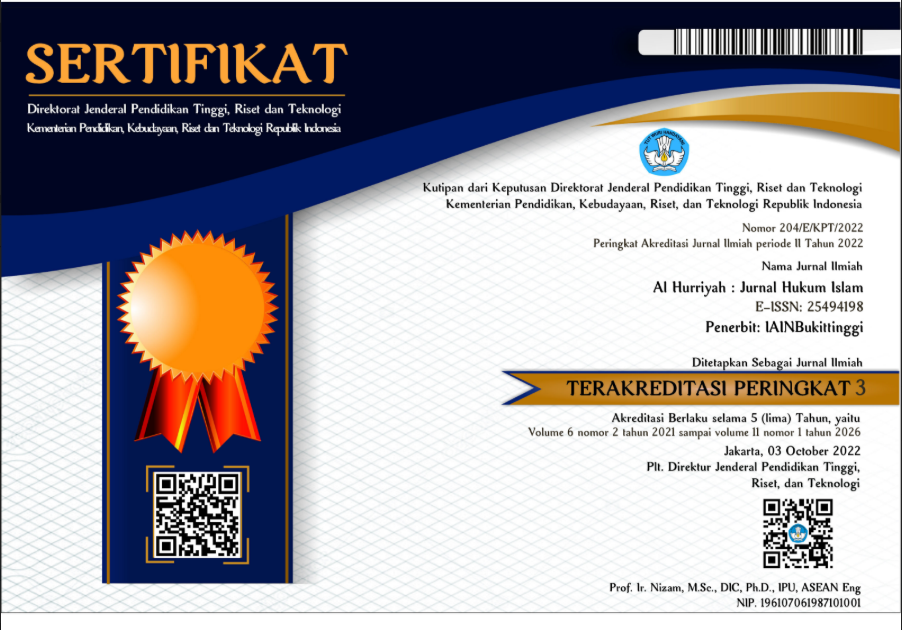QIYÄ€S DAN ANALOGI HUKUM (Suatu telaah dan perbandingannya dalam penemuan hukum)
DOI:
https://doi.org/10.30983/alhurriyah.v2i1.263Abstract
References
Al-Amidi, (1914), Al-IhkÄm fÄ« Usul al-AhkÄm, Kairo: Dar al-Kutub al-Khidiwiyah.
Al-Ghazali, Al Mustasfa min Ilm al-Usul, Beirut: Dar al-Fikr.
_________, Syifa’ al-Ghalil fi Bayan al-Sabah wa al-Mukhl wa Masalik al-Ta’lil, Baghdad: Matba’ah al-Irsyad.
Arrasjid, Chainur, (2001), Dasar-Dasar Ilmu Hukum, Jakarta: Sinar Grafika.
Badran, Abdul Qadir Ibn, (1985), Al-Madkhal ila Mazhab Imam Ahmad Ibn Hambal,(Beirut: Mu’assasah ar-Risalah.
Benawan, Al Andang L., “Hukum, Hakim dan Hikmatâ€, Kompas, Sabtu 2 November 2002.
Dhawalibi, Muhammad Ma’ruf al-, (1965), al-Madkhal ila ‘Ilm Usul al-Fiqh, Dar al-Kitab al-Jadid.
E. Utrecht, (2007), Pengantar Dasar Hukum Indonesia, Jakarta: PT.Rineka Cipta.
Hasan, Ahmad, (1984), Pintu Ijtihâd Sebelum Tertutup, terj. Agah Garnadi, Bandung: Pustaka.
Humam, Kamaluddin Ibn, at-Tahrīr, Beirut: Dar al-Fikr.
Jabiri, Muhammad ‘Abid al-, (1993), Bunyah al ‘Aql ‘Arabī: Dirasah Tahliliyah Naqdiyah li Nizami al-Ma’rifah fi al-Saqafah al-Arabiyah, Beirut: al-Markaz al-Saqafi al-Arabi.
_____________________, (1991), TakwÄ«n al-‘Aql al-ArÄbÄ«, Beirut: al-Markaz al-SaqafÄ« al-ArabÄ«, 1991.
Kansil, CST., (1977), Pengantar Ilmu Hukum dan Pengantar Tata Hukum Indonesia, Jakarta: PT. Ghali Utama.
Kanter, EY dan S. R. Sianturi SH., (1982), Asas-Asas Hukum Di Indonesia Dan Penerapannya, Jakarta: Alumni AHM-PTHN.
Khallaf, Abdul Wahab, (1972), MashÄdir al-Tasrī’ fi mÄ lÄ Nashsha fÄ«h, Beirut: Dar al-Qalam.
Moeljatno, (2009), KUHP kitab Undang-Undang hukum Pidana, Jakarta :Bumi Aksara.
________, (2008), Asas-asas Hukum Pidana, Jakarta: Rineka Cipta.
Raharjo, Satjipto, “Hukum Itu Perilaku Kita Sendiriâ€, Kompas, Senin 23 September 2002.
Schacht, Joseph, (1965), An Introduction to Islamic Law, London: Oxford University Press.
____________, (1950), The Origin of Muhammadan Jurisprudence, London: The Oxford University.
Soeroso, R., (1996), Pengantar Ilmu Hukum, Jakarta:Sinar Grafika.
Subekti, R. dan R Tjitrosudibio, (1992), Kitab Undang-undang Hukum Perdata, Jakarta: Pradya Paramita.
Syarifin, Pipin, (2008), Hukum Pidana di Indonesia, Bandung: Pustaka Setia.
SyirÄzi, Abu IshÄq al-, Al-LumÄ’ fi UsÅ«l al-Fiqh, Beirut: Syirkah al-Maktabah wa al-Matba’ah.
Vollmar, H.F.A., Pengantar Studi Hukum Islam, (1999), Jakarta: PT. Raja Grafindo Persada.
Zahrah, Muhammad Abu, (1954), Ibn Hazm wa Ashru ArĒuh wa Fiqhuh, Beirut: Dar al-Fikr al-Arabī.
Downloads
Published
How to Cite
Issue
Section
Citation Check
License
Authors who publish with this journal agree to the following terms:
- Authors retain copyright and grant the journal right of first publication with the work simultaneously licensed under a Creative Commons Attribution-ShareAlike 4.0 International License that allows others to share the work with an acknowledgment of the work's authorship and initial publication in this journal.
- Authors are able to enter into separate, additional contractual arrangements for the non-exclusive distribution of the journal's published version of the work (e.g., post it to an institutional repository or publish it in a book), with an acknowledgment of its initial publication in this journal.
- Authors are permitted and encouraged to post their work online (e.g., in institutional repositories or on their website) prior to and during the submission process, as it can lead to productive exchanges, as well as earlier and greater citation of published work (See The Effect of Open Access).





